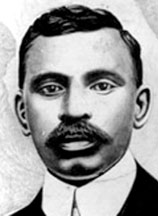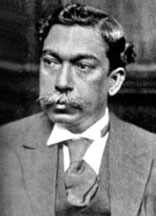A petition in a shoe decides freedom
By Amal Hewavissenti
High on the list of Sri Lanka’s national demands at the outset of the
twentieth century was regaining custody of freedom and independence from
British imperialism. The consequential struggle for independence
(Swarajya Satana) showed the workings of national leaders such as F.R.
Senanayake and E.W. Perera who somehow knocked the British
administrators off-balance and forced the British Crown to put its
decisions under the microscope.
Specially, E.W. Perera’s historic but risky expedition to England
with a letter concealed in his shoe registered a memorable land mark in
the struggle for independence for Sri Lanka. The letter he secretly
carried was a petition to the British Crown against the ruthless
harassment of Sri Lankan people by the representatives of British
government.
 |
 |
| F.R. Senanayake |
E.W. Perera |
The massive influence behind this patriotic operation was F.R.
Senanayake who shouldered the responsibility of all expenses for
Perera’s expedition. Though Sri Lanka seems to have regained freedom
without effort, there has been a constant and serious struggle for it
since the first half of the 19th century. The undiplomatic course of
action that English rulers adopted in their bid to crush down Sinhala -
Muslim riot in 1915 practically brought this struggle to a dramatic
climax.
It was the midnight on 3 June 1915. F.R. Senanayake arrived at his
Kewstok mansion accompanied by a young shoe mender from Kurunegala, a
rather unusual guest at his place. He was soon brought into Senanayake’s
study where he gave the shoe mender a pair of shoes together with vital
instructions. A born expert in the trade of shoe mending, the young man
deftly made a cavity in the shoe heel and tucked, inside it a letter
given by F.R. Senanayake. This was a major task of patriotism, secrecy
and adventure in operation. At the same time the unleashing of the
repressed tension created within Sri Lankans.
The over-riding concern of most of Sri Lankan national leaders was to
save innocent people from the iron grip of English rulers in Sri Lanka.
The petition directed to King George V of Britain highlighted the
widespread injustice to Sri Lankans subjected to killings and torture at
the hand of British rulers. The shoe mender was further instructed to
insert a copy of declaration of martial law imposed by the English in
this country. This special plea was drafted by J.E. Gunasekera who was
once a teacher at Ananda College and the Principal of Mahabodhi
Vidyalaya - Maradana.
(He was later showered with honour for the part he played when the
initial decision was made at Colombo Municipal Council to rename a part
of Kinsey road as “J.E. Gunasekera Mawatha” on 15 Sept 1966).
At this time, the local administrators of British empire strictly
inspected and imposed restrictions on the letters sent from Sri Lanka to
Britain in order to keep the British Crown in the dark about their
despotism and tyranny. Even the foreign tours by responsible people in
Sri Lanka were increasingly restricted or sometimes, banned.
Background of riot
The British Crown never allowed the principle of killing people
cold-bloodedly under martial law in any type of riot or insurgency.
Instead, it demanded a person, only if convicted of a serious crime,
should be given the death sentence. Yet the English administrators in
this country flagrantly violated the British law which notably narrowed
down the powers of the Governor to Pre-empt any injustice.Meanwhile, the
first flames of the world war 1 were rampant and a riot between Sinhala
people and Muslim people were breaking out. There was a high degree of
danger for those going to England by sea as German had employed
“Amerdon” a torpedo to destroy England-bound ships.
The Sinhala - Muslim conflict, which was an accidental expansion from
a minor incident, suffered heavy suppression by Robert Charmers the
Governor of Sri Lanka.
The rulers indiscriminately imprisoned both innocent people and those
who were actively engaged in the riot. Some of the national leaders were
killed but leaders such as F.R. Senanayake, D.S. Senanayake, Sir D.B.
Jayathilaka, Ponnambalam Ramanathan, D.R. Wijewardana, Ponnambalam
Arunachalam injected vitality to the struggle. Sinhala, Tamil and Muslim
people jointly created an organisation called “Lanka Jathika Sangamaya”
to demand democratic rights for Sri Lankans.
The British rulers delayed granting of democratic rights for Sri
Lankans on lame excuses and false grounds and argued that Sri Lankans
were not educated enough to use “universal franchise.”
As the struggle for independence entered a decisive phase, E. W.
Perera unhesitatingly accepted Senanayake’s request to take the
momentous letter to England by ship. In all probabilities, E. W.
Perera’s expedition involved the element of danger and high degree of
risk against the backdrop of increasing tyranny by English
administrators. Had the English rulers got the slightest notion of E. W.
Perera’s motive behind the journey, he would definitely have been deemed
not to go to England, but to the grave. The 1848 insurgency witnessed
the most ruthless and brutal suppression of rebels by English rulers.
Purpose in disguise
The Governor Robert Charmers, completely neglecting the British law
imprisoned and even killed many national leaders in their violent
attempt to oppose the imperial rule in Sri Lanka. Under the situation,
the letter (petition) contained a true picture of the dark atmosphere
that pervaded.
Intimidations, imprisoning and killing of innocent people were a
nation wide problem and specially imprisoning responsible leaders in the
freedom struggle was a daily occurrence across the country. At this time
Sri Lankan government officials were not allowed to travel to England
except for an official duty or for educational pursuits. E. W. Perera
obtained the legal permission for his England tour from Sri Anton
Bertrom, the then attorney-general, under the guise of an official going
for educational advancement.
In June 1915, he set out for England with the petition pressed tight
in the shoe he was being shod. It look him virtually one month to reach
England. Thanks to his sacrificial efforts, the national leaders who had
been sentenced to death, were released on the order of British crown.
History records that the politic course of action and discernment of F.
R. Senanayake and E. W. Perera saved many people who were doomed to be
killed cold bloodedly under martial law without any propertrial.
The first thing he did in England was to complain to British
government about the illegalities of the martial law which accounted for
a widespread carnage.
He earnestly appealed to the British crown to cancel out the tyranny
and despotism by English rulers in Sri Lanka. Though the British crown
did not, at first, appear to be credulous of what he said, he managed to
offer concrete proof of English tyranny and obtained a strict order for
the English administrators to stop unlawful killing of people.
E. W. Perera’s persistent protest in England was a perfect recipe for
the violent and open charge made by Theodor Taylor in English Parliament
against the British administrators in Sri Lanka and the turmoil they had
created in the country. In the wake of Taylor’s charges against English
rulers in Sri Lanka, the leading newspapers in England mounted a massive
protect against the tyranny and created a public opinion against the
despotic rule of English. The newspapers such as “London Daily News”,
“Review of the Reviews”, “Globe”, “Nation” and some associations seized
the opportunity to severely denounce the inhuman treatment of people in
Sri Lanka.
The unmatched organiser behind all this was E. W. Perera who
transformed the customary opinions of the British crown and who
shouldered his responsibilities for the welfare of the nation and the
country.
He stayed in England for almost four years creating the favourable
atmosphere to make Sri Lanka a fully independent State and all his
expenses were borne by F. R. Senanayake. Undoubtably, the moment has
come to honours these great leaders was sacrificed all their personal
objectives for a common cause and engaged in a life and death struggle
to bring independence for the people of Sri Lanka.
|

